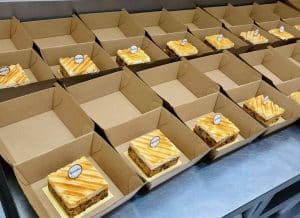-
Email: contact@locaba.sg
-
Phone +65 8876 5127
Islandwide delivery $15 – FREE from $150 order!
-
Email: contact@locaba.sg
-
Phone +65 8876 5127
The Office Afternoon Nap

Recently I was asked by some friends from a Viennese Office Center to write a technical paper on the topic of “Fatigue After Eating” for the companies located there. I was happy to comply with this request, as it is one of my core topics and of course has a little bit to do with diabetes. (See our diabetic-friendly cakes.) Have fun reading!
THE TIREDNESS

Let’s be honest, who of us has never been embarrassed to close 1-2 eyes after a meal and was taking a little nap? I confess, not only once before did I feel a sudden strong tiredness after lunch and the lines on the screen in front of my eyes became more and more blurred.
THE LUNCH
Very few of us know that this sudden tiredness is in most cases directly related to the lunch we have eaten shortly before – and could easily be avoided. However, this does not mean that we have to make do with salad leaves and vegetable stew only, quite the contrary. No matter whether it’s canteen food, a fast food restaurant, a hawker center around the corner or a walk to the pub next door – usually our lunch consists of far too many carbohydrates – namely those of the “bad” kind… (We at LOCABA avoid bad carbs – see low-carb cakes!)
THE CARBOHYDRATES
Generally, we distinguish the so-called isolated carbohydrates such as sugar from the “quickly available” and complex carbohydrates. We should at least reduce the first two considerably, as they cause a real blood sugar rollercoaster during the course of metabolism.
It is precisely these blood sugar peaks that can cause severe fatigue after a meal!
JUNK FOOD
The consumption of pasta, pizza, potatoes, rice, everything “breaded” as well as most bread & pastries may be a popular “vice”, but the consequences of a regular consumption of these said foods are strongly underestimated. This “high carb nutrition” consists of a quantity of the “quickly available” carbohydrates cited above, which are converted into glucose (= blood sugar = glucose) in the course of metabolism.
THE INSULIN
Insulin, which is simultaneously produced and secreted by the pancreas, is responsible for the “sugar” being introduced into the cells. This process is nothing bad in itself, but if we eat like this all the time, the pancreas must also produce large quantities of insulin on a regular basis.
The consequence of such “excessive” carbohydrate consumption is a so-called insulin resistance. This means that our cells become increasingly insensitive to our own insulin. By the way, this is the preliminary stage of diabetes type 2, one of the worst civilisation diseases of our time.
If the recent rise in obesity prevalence continues, the lifetime risk of type 2 diabetes in Singapore will be one in two by 2050 with concomitant implications for greater healthcare expenditure, productivity losses, and the targeting of health promotion programmes.
Source: BMJ Open Diabetes Research & Care
THE “HARMLESS” SLEEP
We remember: It began with a supposedly harmless office afternoon nap. We were just a little tired after dinner. What is unusual about that?
Of course, not everyone who is tired now and then after lunch automatically runs the risk of becoming diabetic. But in my humble opinion it is at least a deeply underestimated indication that one should pay more attention to this warning signal.
LOW CARB
Today I know that diabetes type 2 is primarily a nutritional disease. It is primarily caused by malnutrition, but it is also best treated in the same way. Namely through the “right” diet. This is done with a highly carbohydrate-reduced diet – also known as low carb, because diabetics can no longer efficiently metabolise carbohydrates. One could justifiably conclude that type 2 diabetics have a kind of carbohydrate intolerance.





